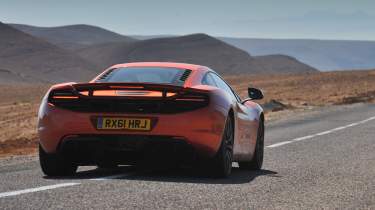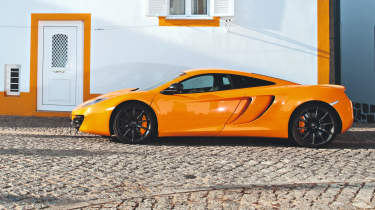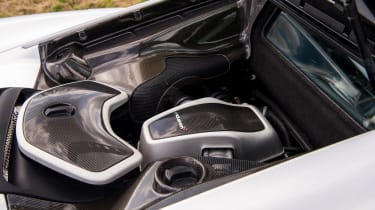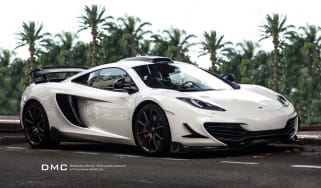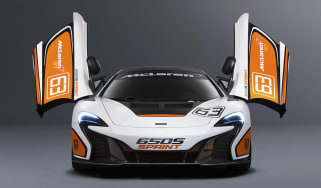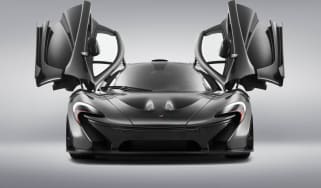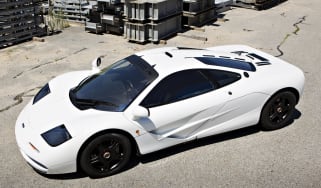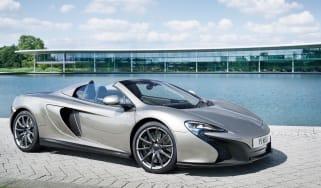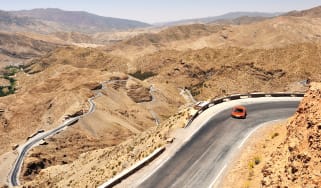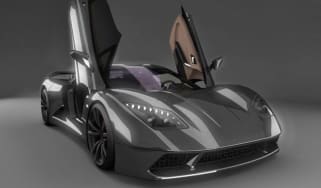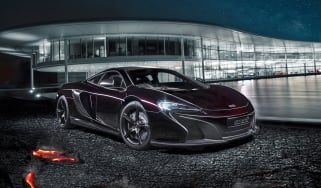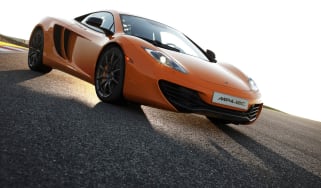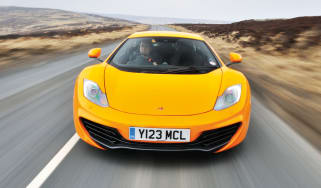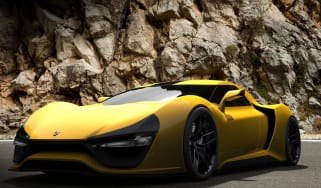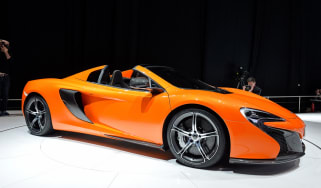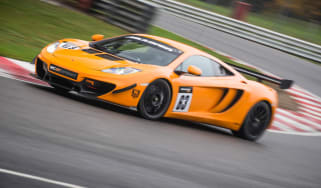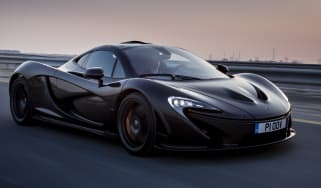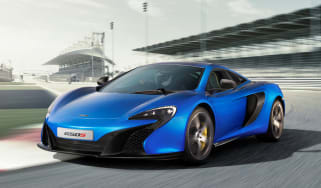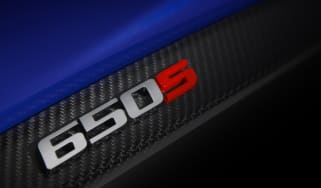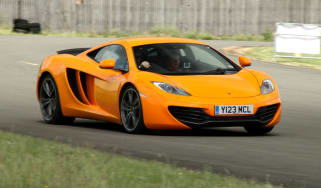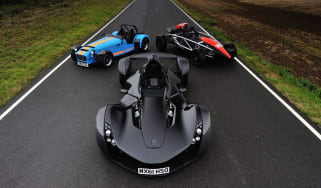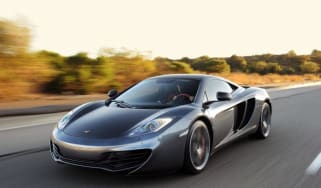McLaren MP4-12C (2011 - 2014) – Ferrari 458 performance for used Porsche 911 money
McLaren's MP4-12C was the company's first step to taking on Ferrari, and what it lacked in emotional connection it made up for with searing performance setting the blueprint for what was to come.
The McLaren MP4-12C could fairly be described as a ‘Game-changer.’ Aside from being a cliché beloved of car writers, the dictionary defines it as ‘an event, idea or procedure that effects a significant shift in the current way of doing or thinking about something’.
No arguments, then, for the 12C (as it came to be known) heralded a new breed of supercar; fielding new technologies from its composite construction to its suspension system, set new dynamic and performance standards and made for such a compelling foe to Ferrari’s 458 on launch that Maranello rejigged its entire supercar strategy and development trajectory in response. It was far from perfect, the 12C, but it was a game-changer and it is an icon.
History
The 12C wasn’t just a new kind of supercar but a new entry from a new manufacturer. A new manufacturer with a decades-long history, notwithstanding. There’d been two McLaren road cars before: the Bruce McLaren/Gordon Coppuck-designed M6GT in the late 1960s (of which three prototypes were built), and Gordon Murray's McLaren F1 launched in 1993, built under the McLaren Cars banner. But the MP4‑12C was part of a new enterprise: McLaren Automotive.
That enterprise in some ways got a soft launch with the Mercedes-Benz SLR McLaren grand-tourer-cum-supercar collaboration, produced from 2003. The intention was for that partnership to create a wider family of Mercedes-engined McLaren cars (beginning with a supercar, a hypercar and a more affordable sports/supercar, i.e. 12C, P1 and 570). That didn’t transpire and instead McLaren went it alone, designing its own engine and creating its own parts bin. No small task.
More reviews
With a front-running F1 team, plus electronics and technology supplier and consultancy businesses already on the McLaren Group’s plate, why diversify into road car production too? ‘When I stood in the [Formula 1] pitlane three years ago, I realised there was only one other team that had been there in 1966, and that was Ferrari,’ McLaren boss Ron Dennis told evo’s Richard Porter in 2010. ‘I started to think about all the teams that had come and gone, and I realised that if you really want to protect the workforce, protect the brand, you have to broaden the brand.’
Mercedes-powered or otherwise, the 12C was always planned to be a carbon-tubbed, mid-engined supercar. It gained the green light for production under the internal codename of P11, and a small, dedicated team was rapidly assembled to create it, among them Chris Goodwin, appointed as chief test driver.
‘Clinical’ was the adjectival stick used by various journalists to beat the 12C. I wonder if the V8’s slightly gruff voice and subtle turbocharged fuzziness to its throttle response might have had a bearing on that. Driving it today, you can see how the Ferrari 458’s zingy, zesty response and easy-as-pie manettino to unshackle its traction and stability controls might have won more hearts.
But the 12C still makes a serious impression. Holding its elliptical steering wheel and feeling the weird duality of the ferocity of its twin turbos and calmness of its chassis, it’s impossible not to admire the freshness of its approach and bravery of its ambition.
In 2014 it was superseded by the 650S: ‘The car the 12C would have been with more [development] time,’ Goodwin says. ‘I can say it now, because I don’t work at McLaren anymore and a lot of water’s passed under the bridge: I’ve driven cars from all kinds of manufacturers since, seen how other people do things and what the 12C lacked. It did run out of time; the detail calibration – tuning of the powertrain, throttle response, gearshift character.’
Its ultimate development was the sensational 675LT of 2015, an all-time great driving experience, while the 720S and 600LT were crowned evo Car of the Year in 2017 and 2018 respectively. (The MP4‑12C missed out by one point to the 911 GT3 RS 4.0 in 2011.) ‘The 650 and 675 weren’t very different mechanically but we all learned it’s not just about being fast; it’s about all the other attributes that help you enjoy the car,’ Goodwin says.
The 12C established the fundamental character matured and honed in subsequent McLaren cars. Heeding the ‘clinical’ criticisms, in developing the Sports Series, which began with the 570S, steps were taken to make the car more playful, including selecting a tyre that prioritised a fun balance over the best lap time, for example.
Goodwin says the 12C’s abilities and impact changed other supercars, too: ‘It was a game-changing car for Ferrari as well. Ferrari would not be the company it is today without the 12C. I do a lot of work which involves driving lots of different cars now, including Ferraris. What they’ve achieved is amazing, and a lot of aspects of their cars’ performance and handling changed as a direct result of the 12C.’
Engine, gearbox and technical highlights
This particular car, with its metallic silver body and tobacco-brown interior, marks the dawn of McLaren Automotive as a production car marque: this is Job One, the first MP4‑12C intended for public sale. It’s led quite a busy life.
A number of bold technology decisions on the 12C included the innovative Proactive Chassis Control (PCC) suspension system; Brake Steer, which precisely nipped the inside-rear brake in place of a limited-slip differential; a clean-sheet, twin-turbo powerplant, and McLaren’s own native infotainment and satnav system, dubbed IRIS. No wonder those early production cars suffered a few electrical teething troubles.
One of the early ’leccy gremlins Job One helped cure during its time with the development department was the finger-swipe door-opening panel. In a futuristic touch (literally), there are no traditional handles on the original MP4‑12C; you instead trace your fingers on the underside of the door panel to unlock the door before lifting it upwards. The system could be recalcitrant, but today it’s working perfectly (happily, since it’s raining). Later, updated cars were given physical switches, however.
There was some debate initially as to whether or not the engine should be turbocharged. ‘My feeling was it should be naturally aspirated, because I’d had nightmares racing a turbocharged Lotus in GT1 – we never finished a race,’ Goodwin recalls. ‘And it was a bit of a nightmare because it took a long time to get the [MP4‑12C’s] engine running properly and that meant the chassis development side of things was squeezed.’
Twin turbos did give the 3.8-litre M838T engine serious firepower, however; more than its natural rival, the 562bhp naturally aspirated Ferrari 458 Italia. (Incidentally, testing of the McLaren engines began in the back of modified Ferrari 360 mule cars.) The MP4-12C had guts too, with 80 per cent of its 442lb ft of torque available at just 1900rpm. Designed with a flat-plane crank, it revved to the stratospheric heights of highly-strung rivals, but thanks to its pair of turbochargers hit with a thick wave of torque that made light work of its lithe 1300kg kerb weight.
At launch, the MP4‑12C developed 592bhp, but an upgrade in 2012 increased that to 616bhp. At the same time, its name was shortened to simply ‘12C’ after criticism that the full name, based on internal company conventions, sounded a little unmemorable and unemotional. The C stood for carbon, in deference to the construction.
Not only did the MP4-12C’s engine set new supercar benchmarks, like its Italian contemporary it also featured a seven-speed dual-clutch gearbox. As with the rest of the car, McLaren’s Formula 1 ties shone through, as the transmission brought with it a selection of aspects that continue to be defining features in all McLaren road cars.
First were the paddles, which were connected on a rocker, giving the driver the option to push or pull the paddle in either direction to change both up and down. The paddle also featured a pre-cog system, which through two stages of movement would allow the driver to inform the gearbox with an extra layer of certainty which gear he or she wanted to select. Furthermore, the gearbox was able to be tied into the MP4-12C’s complex traction control and brake-steer systems and able to be configured alongside the engine and chassis, softly slipping between gears or punching through them like a pneumatic racing ’box in a GT3 race car depending on where the switch was set.
At each double-wishboned corner, there’s a spring and an adaptive damper, but the special sauce is in the PCC system’s hydraulic interconnection between all four corners, with high- and low-pressure valves, pressurised by the power steering pump. There are no anti-roll bars, though there is a ‘Z-bar’ at the rear, to reduce squat under acceleration.
The intention of PCC is to separate ride and handling – one often being a compromise to the other. In a straight line, the dampers allow the wheels to smoothly absorb the road. Sensors monitor ride height and steering input, and the instant you introduce the 12C to a corner, the adaptive dampers and hydraulic links provide the exact roll support each wheel needs.
‘To decide whether to use the cross-link hydraulic system, we tested the suspension back-to-back in two Subarus,’ Goodwin explains. ‘We used Dunsfold [airfield test track] a lot for that work.’ The difference proved dramatic: PCC got the green light. So did Brake Steer – a system first engineered for McLaren’s F1 cars in the late ’90s with a second brake pedal to drag the inside-rear brake slightly to help the car turn.
Goodwin tested the system at Dunsfold, using a brake lever on the steering column of a test mule, working out where it was useful to apply the brakes on one side, then the other. The performance gain was demonstrable, and meant the 12C could forego the extra weight of a traditional limited-slip diff. ‘They were hard choices,’ Goodwin recalls. ‘No-one had used that suspension or Brake Steer before. In a bigger company you wouldn’t have done that. There was a culture of doing things differently.’
Driving the McLaren MP4-12C
Raising the door takes some of the sill with it, exposing the carbon MonoCell chassis, which weighs less than 80kg. It’s still a bit of a yoga move to torso-twist/limbo your way beneath the door and drop into Job One’s well-worn driver’s seat. The interior today is a mixture of futuristic and dated. The instrument panel is part analogue, with a prominent central tacho (redlined at 8500rpm), and part digital with satellite displays either side, their shape echoing the 12C’s rear graphic.
Their McLaren-orange typeface looks a little pixelated compared with today’s pin-sharp graphics, but it’s a key part of the car’s visual identity. The odometer shows 40,704.1 miles (we’ll add another 510 during our time together). Further switches and displays are split between the inside of the doors, for the climate controls, and a slim central spar, the better to place you toward the car’s centre.
That sites the buttons for Drive, Neutral and Reverse, the Active Panel, which separates driving modes for chassis and powertrain via wingnut-shaped switches, and the portrait-orientated IRIS screen, with clean graphics but a slightly fiddly interface. (The need to continually update its software and mapping would ultimately be another expensive complication in the 12C’s life.) This car’s interior was refurbished for 2016 together with an exterior respray, having suffered from a revolving door of laptop-clutching engineers and test drivers in its development testing role.
It’s a race-car-ish driving position: low hips, straight legs, slightly reclined torso. This was a clean-sheet design, with no legacy platform to build around. ‘I spent some time in the design studio sat in a wooden box,’ Goodwin recalls of the process to set the 12C’s hip point and sight lines.
The steering wheel, with its button-free, carbonfibre spokes, feels great too. ‘We were able to carry Formula 1 stuff across,’ he says. ‘The grip of a McLaren steering wheel is not circular, it’s elliptical – and it’s exactly the same as the McLaren Formula 1 steering wheel of that era.’ On the back of the wheel are rocker-mounted push-pull paddles for the seven-speed dual-clutch gearbox.
Getting underway, the steering strikes you immediately. As with all McLarens, it has a lovely, measured, accurate feel, with plenty of hydraulically assisted feedback. It’s less hyper-sensitive than in some supercars, but livelier than in later McLarens, pulling about a little and filtering out fewer road-surface imperfections.
The brake pedal is positioned relatively centrally, allowing you to left-foot brake if you wish. It needs a firm press, a little like a racing car’s, although the brakes are a tad grabby at the top of the pedal. Beyond that, there’s lots of feel and feedback, just like the steering. Brake hard and there’s a total eclipse of the rear-view mirror, as the active airbrake stands to attention.
There’s less sharpness in the throttle response: a little turbo-lag at lower revs lends the McLaren-designed, Ricardo-manufactured 3799cc V8 a slightly woolly edge. A slightly gruff, monotone voice, too. These bumpy roads demo PCC to good effect, and ride quality is impressively smooth. On the flipside, I find the 12C a harder car to read initially than some mid-engined sports cars and supercars; in a comparatively low-tech, strut-based Porsche Cayman, for example, you hit a bump and feel it affect the car as a whole accordingly. In the 12C, the visual cues you’re getting don’t always match the physical ones you’re feeling through the chassis.
After a while you begin to trust it, however, and its cornering performance and ultimate limits are remarkably high. Rain is falling steadily now, the single wiper constantly arcing across the screen. I always feel a bit nervous of heavily turbocharged cars in the wet, in case they come on-boost at an unhelpful moment.
But the 12C is a stable, trustworthy car. There’s plenty of mechanical grip and a benign balance when you do, eventually, start to breach its limits. That said, even with Google’s help, I can’t work out how to fully disable the stability control; it’s something of a safe-cracking exercise, requiring a cheat-code button sequence on the Active Panel.
It’s notable how easy-going the 12C is at urban speeds, too. Everyday drivability at slower speeds, as well as high, and refinement from noise and vibration was a priority from the outset. As you flick through the Active Panel’s mix-and-matchable modes, with three apiece for the suspension and powertrain, the engine takes on much more of an edge, both in response and in note. Remarkable performance aside, the MP4‑12C received a slightly cautious response at launch; admiration rather than adoration.
Perfectionism is a double-edged sword but, in striving for it, the 12C moved the goalposts for the supercar field as a whole. It’s a before/after car, and we’re richer for it.
evo Car of the Year 2011: The reckoning
‘The MP4-12C shouldn’t be second. It should be on the top step, crowned evo Car of the Year 2011. ‘I had my most memorable drive of the test in the MP4-12C and went faster than I would have thought possible,’ said Henry Catchpole. ‘I expected it to be a bit bland and a bit computer-gamey but it’s not,’ said Richard Porter.
‘‘There are moments when it’s doing stuff that goes much further than exposing its competitors in this test – it questions the fundamentals of what a sporting car should be; how it should behave,’ said Chris Harris. But it finishes second because almost all complimentary comments on the McLaren were followed by ‘...but...’. When it was right, the McLaren was nigh-on untouchable, but almost from the moment its wheels hit the warm Portuguese asphalt it was troubled by niggles and issues. Some of us only experienced it as it should be late in the test.
‘Then it was devastatingly effective, utterly engaging, ludicrously wieldy and fast; a car to show up the shortcomings of the Ferrari 458 which beat it in our summer group test (issue 159). But… ‘There’s this feeling that you’re not driving the finished article,’ said Catchpole. And that’s what tempered the enthusiasm of too many of us. ‘It was so close,’ said Roger Green. ‘Even if it had been on the standard [non-ceramic] brakes, it might have won. Maybe next year...’ – Richard Meaden, who tested the MP4-12C on eCoty 2011.
McLaren 12C values and buying guide
McLaren Automotive has sailed in choppy financial waters in recent years and faced greater challenges than Ron Dennis envisaged when he cast his eye up and down the F1 pitlane in the late noughties. There are perhaps uncomfortable parallels between the 12C and the hybrid Artura: early teething troubles and a design that some love for its subtlety and others feel lacks drama. But in its facelifted form, the Artura has become a superb driver’s car, just as the 12C became with the 650S.
At launch in 2011 it cost £168,500. Today, values range from £60,000 to £90,000, depending on mileage and condition. A £60k 12C is a brave buy, but a serious car for the money. Though taking that plunge isn’t a decision one should take likely, or without another £40k in your back pocket, for the likely event that your chosen 12C decides to throw a mechanical or electrical wobble.
Though the very cheapest 12Cs will be the earliest cars with the IRIS 1 digital hardware, it’s worth paying the extra for a later car with IRIS 2 – a much more capable infotainment system and architecture that proved to be more futureproof too. Beyond this, some 12C issues are universal. McLaren engines are sensitive even with diligent servicing, with issues reported on everything from the turbo plumbing, to the con rods.
Likewise the PPC damping system, which while clever, can be troublesome. Leaks are common, drops in hydraulic pressure are almost a case of ‘when’ not ‘if’. Buy a car with a refreshed system or at least, one with accumulators that have been recently refurbished by a specialist such as Thorney Motorsport (who also have a useful spare parts offering for folding money off what a dealer would charge). Bubbling paint isn’t rust obviously, being a composite car. Rather it’s evidence of moisture inside the laminate structure that’s expanded.
It’s for all these reasons and the teething problems 12Cs had when new that they’re a latterday darling for supercar depreciation and value for money. Prices for early 12Cs have however levelled out – ‘people are waking up to the fact that it has investment potential,’ says specialist Alastair Bols.
‘I reckon there are 250-300 coupes in the UK, and around 100 Spiders, so not a huge number. About ten per cent of those are on the market.’ Expect to pay from £60-70k for an early car with a standard spec and high mileage, with lower mileage, carbonfibre extras, IRIS 2, etc bringing asking price up to the £100,000 for the very best examples.
Specs
| Engine | V8, 3799cc, twin-turbo |
|---|---|
| Power | 616bhp (post-upgrade) @ 7500rpm |
| Torque | 442lb ft @ 3000-7000rpm |
| Weight | 1434kg |
| Power-to-weight | 436bhp/ton |
| Tyres as tested | Pirelli P Zero |
| 0-62mph | 3.3sec |
| Top Speed | 207mph |
| Basic price new | £168,500 |
| Value today | £60,000-90,000 |

